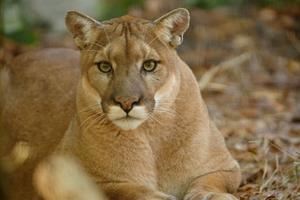WCS News Releases
July 29 -
Public Says OK to Cougars in the
Adirondacks, if they come back
on their own
ssmith posted on July 29, 2015 11:12
A new paper from WCS (Wildlife Conservation Society) looks at the social aspects and public attitudes with regard to a potential mountain lion re-colonization in the Adirondack Park. The paper finds that more than three-quarters of residents and visitors would support the idea should the animals return on their own. That support significantly drops, however, when asked about an intentional release of the big cats.
At the time of European contact with the New World, mountain lions could be found from coast to coast and from Canada to the tip of Argentina. Considered to be a threat to humans, livestock, and game, their range was reduced dramatically. They were extirpated from New York State by around 1885.
In 2011, a mountain lion (also called cougar, panther, painter or catamount) was struck and killed by a car in Connecticut. Genetic data from hair samples identified this individual as one previously captured in South Dakota’s Black Hills. The animal had traversed the northern United States through Minnesota, Wisconsin, and New York State – passing through the Adirondack Park.
“Cougars can disperse over large distances; if one can make it, others are likely to have made the journey in the past or will do so in the future,” said lead author of the paper, Eliza McGovern who completed the study as part of a graduate degree at the Yale School of Forestry and Environmental Studies. “In this context, it is important to understand the public mind-set with regard to these dispersing individuals as well as the potential for a future population in the park.”
The study, “Predicting support for re-colonization of mountain lions (Puma concolor) in the Adirondack Park,” appears in early view in the Wildlife Society Bulletin. Authors include Eliza B. McGovern and WCS’s Heidi E. Kretser.
WCS initiated this study as it presented a rare opportunity to understand public perceptions prior to a species’ return to a region. With this knowledge, we can compare how perceptions change over time should mountain lions return, and be pro-active about managing to anticipate and avoid potential human-wildlife conflicts.
The scientists conducted a survey of 315 residents and visitors from across the Adirondack Park in the summer of 2013. Two of the questions from this questionnaire were also added to Cornell University’s Survey Research Institute’s Empire State Poll given to 800 respondents across New York State in early 2014. The polls were designed to gauge what respondents knew about mountain lions, their attitudes toward restoration of the animal’s populations in the park, management preferences, and what level of risk they perceive for themselves, their children, their livestock, and pets.
Results showed that 86.7 percent of Adirondack respondents knew that mountain lions lived in the park in the past and although they are officially listed as extinct in New York State, only 18.7 percent of the respondents indicated that mountain lions do not currently exist in the Adirondacks. In fact, 15.2 percent responded that they had personally seen a mountain lion in the Adirondacks. When asked if mountain lions “lived in the area, would you worry about your children playing outside,” 41.3 percent answered in the affirmative. Additionally, 22.5 percent would keep their pets inside and 34.9 percent would change their recreation habits.
Despite this, more than three quarters of all Adirondack respondents (non-residents 84.1 percent, residents 69.8 percent) supported the hypothetical idea of mountain lions naturally returning to the Adirondack Park. About half of the respondents felt that wildlife agencies should act to encourage a population in both the Adirondack survey and the Empire State Poll. However, when asked if they would like mountain lions to be intentionally released into the park, only 35.7 percent of residents and 40.2 percent of non-residents were in support of the idea.
WCS Livelihoods Coordinator Heidi Kretser said, “That such a percentage of people in this survey believe mountain lions exist in the park and are supportive of a natural re-colonization suggests that wildlife managers seriously consider a communications and public outreach strategy about mountain lions in the Adirondacks.”
Currently, there are no plans to take action to restore mountain lions to the Adirondacks. But as the authors point out, “mountain lions, among many other historically persecuted carnivores, are naturally recovering their population and range in many parts of the United States.” Although there is not yet an established population in the Adirondacks,
understanding human attitudes toward this species would help to inform their management and conservation if they do return. With the polling, the scientists also looked to establish whether the survey results could inform future communications about mountain lions in the Adirondacks. Greater specificity, they said, about the possible management interventions to encourage recolonization of mountain lions in the Adirondacks or the Northeast would require detailed biological surveys and a larger-scale randomized survey of residents and visitors to the Adirondacks, the rest of New York State and surrounding states and provinces.
understanding human attitudes toward this species would help to inform their management and conservation if they do return. With the polling, the scientists also looked to establish whether the survey results could inform future communications about mountain lions in the Adirondacks. Greater specificity, they said, about the possible management interventions to encourage recolonization of mountain lions in the Adirondacks or the Northeast would require detailed biological surveys and a larger-scale randomized survey of residents and visitors to the Adirondacks, the rest of New York State and surrounding states and provinces.
To see a copy of the report, click here.














No comments:
Post a Comment